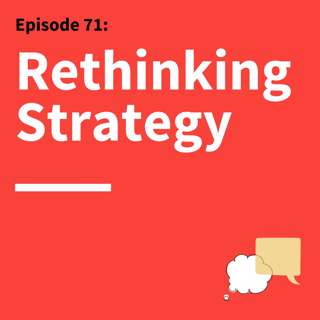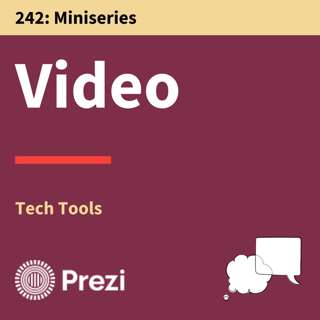
72. Quick Thinks: Talk It Out – How to Successfully Negotiate and Resolve Conflict
When it comes to negotiating and managing conflict, Professor Michele Gelfand says it’s time to get creative.Everybody has wants and needs. So what do we do when our priorities compete with those of other people? According to Gelfand, a professor of organizational behavior, negotiations and conflict management are exercises in creative problem-solving, ones where we look for ways to not only get what we want, but for those on the other side of the table to get what they want too. “The best negotiators tend to be the most creative,” says Gelfand.In this episode of Think Fast, Talk Smart, Gelfand joins Matt Abrahams to discuss how creative communication can help us find solutions where everybody wins.Connect:Premium Signup >>>> Think Fast Talk Smart PremiumEmail Questions & Feedback >>> hello@fastersmarter.ioEpisode Transcripts >>> Think Fast Talk Smart WebsiteNewsletter Signup + English Language Learning >>> FasterSmarter.ioThink Fast Talk Smart >>> LinkedIn, Instagram, YouTubeMatt Abrahams >>> LinkedIn ********Thank you to our sponsors. These partnerships support the ongoing production of the podcast, allowing us to bring it to you at no cost.Strawberry.me. Get 50% off your first coaching session today at Strawberry.me/smart
22 Nov 202214min

71. Strategy Success: How to Communicate Your Gameplan
As Professor Jesper Sørensen sees it, a winning strategy is the result of conversations, not commands.Sørensen says strategy can be directed from the C-suite, but it doesn’t have to be. “Lots of great strategies are discovered,” he says, “they're discovered because the leaders were able to listen to their frontline workers or their frontline managers.” A more iterative approach, says Sørensen, helps companies adapt their strategy to an ever-changing landscape.In the latest episode of Think Fast, Talk Smart, Sørensen joins host and lecturer Matt Abrahams to discuss how organizations can use better communication to craft better strategies.Connect:Premium Signup >>>> Think Fast Talk Smart PremiumEmail Questions & Feedback >>> hello@fastersmarter.ioEpisode Transcripts >>> Think Fast Talk Smart WebsiteNewsletter Signup + English Language Learning >>> FasterSmarter.ioThink Fast Talk Smart >>> LinkedIn, Instagram, YouTubeMatt Abrahams >>> LinkedInEpisode Reference Links:Making Great Strategy: Arguing for Organizational Advantage, by Jesper B. Sørensen Glenn R. CarrollClass Takeaways: Crafting and Leading Strategy: Five lessons in five minutes — Professor Jesper Sørenson teaches how to create and implement a successful business strategy. ********Thank you to our sponsors. These partnerships support the ongoing production of the podcast, allowing us to bring it to you at no cost.Strawberry.me. Get 50% off your first coaching session today at Strawberry.me/smart
8 Nov 202227min

70. Ideas Fuel Innovation: Why Your First Ideas Aren’t Always the Best
What’s the secret to coming up with good ideas? For Jeremy Utley, it’s about generating as many as possible. The director of executive education at the Stanford d.school, Utley says, “very few problems we face in business or in life have a single right answer.” All ideas — the good, the bad, and the ugly — are “a necessary input to an innovation process,” and an essential step in getting to solutions that will actually work.In this episode of Think Fast, Talk Smart, Utley and host Matt Abrahams explore how we can focus less on finding the “right” answer and open ourselves up to more innovative ideas.Connect:Premium Signup >>>> Think Fast Talk Smart PremiumEmail Questions & Feedback >>> hello@fastersmarter.ioEpisode Transcripts >>> Think Fast Talk Smart WebsiteNewsletter Signup + English Language Learning >>> FasterSmarter.ioThink Fast Talk Smart >>> LinkedIn, Instagram, YouTubeMatt Abrahams >>> LinkedIn ********Thank you to our sponsors. These partnerships support the ongoing production of the podcast, allowing us to bring it to you at no cost.Strawberry.me. Get 50% off your first coaching session today at Strawberry.me/smart
25 Okt 202225min

69. Feeling Nervous? How Anxiety Can Fuel Better Communication
Stress, anxiety, nervousness — when these feelings inevitably arise, lecturer Kelly McGonigal says it’s not about making them go away, but using them to your advantage.“What I have come to value about anxiety,” says McGonigal, “is it’s a sign that I care.” As she explains, feelings of stress alert us to things that matter to us and help us stay present in the moment — particularly useful, she says, when it comes to communication.In this episode of Think Fast, Talk Smart, McGonigal and host Matt Abrahams discuss how to channel stress toward more effective communication and to a deeper connection to our own purpose and meaning.Connect:Premium Signup >>>> Think Fast Talk Smart PremiumEmail Questions & Feedback >>> hello@fastersmarter.ioEpisode Transcripts >>> Think Fast Talk Smart WebsiteNewsletter Signup + English Language Learning >>> FasterSmarter.ioThink Fast Talk Smart >>> LinkedIn, Instagram, YouTubeMatt Abrahams >>> LinkedIn ********Thank you to our sponsors. These partnerships support the ongoing production of the podcast, allowing us to bring it to you at no cost.Strawberry.me. Get 50% off your first coaching session today at Strawberry.me/smart
11 Okt 202228min

68. Directive vs. Dialogue: Communicating Better as a Leader
As the dean of Stanford Graduate School of Business, Dean Jon Levin knows the importance of crafting the right message and sharing it in the right way. But, as he says, one of the biggest challenges for any leader is to know what to communicate, and how. How do leaders strike the balance between being clear and directive, and as Levin says, “leaving space for people to form their own opinions, to discuss ideas, to debate”? He joins host and lecturer of strategic communications Matt Abrahams to discuss on this episode of Think Fast, Talk Smart.Connect:Premium Signup >>>> Think Fast Talk Smart PremiumEmail Questions & Feedback >>> hello@fastersmarter.ioEpisode Transcripts >>> Think Fast Talk Smart WebsiteNewsletter Signup + English Language Learning >>> FasterSmarter.ioThink Fast Talk Smart >>> LinkedIn, Instagram, YouTubeMatt Abrahams >>> LinkedIn ********Thank you to our sponsors. These partnerships support the ongoing production of the podcast, allowing us to bring it to you at no cost.Strawberry.me. Get 50% off your first coaching session today at Strawberry.me/smart
27 Sep 202221min

67. What Is Normal? How Culture Affects Communication Styles
Why do we drive on only one side of the road? Why don’t we sing in libraries? Why wear a swimsuit?For Professor Michele Gelfand, it all comes down to culture. As a cross-cultural psychologist, Gelfand is fascinated by social environments and their effects on human behavior, particularly, how strictly people adhere to social norms.In this episode of Think Fast, Talk Smart, Gelfand joins host and lecturer of strategic communications Matt Abrahams to explain why some cultures are “tight” and “have strict social norms,” while others are “loose,” with “more permissibility of behavior.”Connect:Premium Signup >>>> Think Fast Talk Smart PremiumEmail Questions & Feedback >>> hello@fastersmarter.ioEpisode Transcripts >>> Think Fast Talk Smart WebsiteNewsletter Signup + English Language Learning >>> FasterSmarter.ioThink Fast Talk Smart >>> LinkedIn, Instagram, YouTubeMatt Abrahams >>> LinkedInEpisode Reference Links:Threatening Language Can Be Contagious. This New Tool Tracks Its SpreadWhy the Pandemic Slammed “Loose” Countries Like the U.S.Rule Makers, Rule Breakers: How Tight and Loose Cultures Wire Our WorldMindset Quiz: How Tight or Loose Are You? ********Thank you to our sponsors. These partnerships support the ongoing production of the podcast, allowing us to bring it to you at no cost.Strawberry.me. Get 50% off your first coaching session today at Strawberry.me/smart
13 Sep 202222min

66. Rethinks: Lessons from Neuroscientist Andrew Huberman to Help You Hack your Speaking Anxiety
“There’s no difference between the physiological response to something that you’re excited about and something that you’re nervous about or dreading,” says Andrew Huberman associate professor of neurobiology and ophthalmology at Stanford University.In this “Best of” episode, we revisit one of our most popular interviews. In it, Huberman, from the wildly popular Huberman Lab Podcast, shares his research on the autonomic continuum, a spectrum between states of high alertness or fear all the way down to deep sleep, and shares how to use the system to your advantage. “If people can conceptualize that the anxiety or stress response is the same as the excitement response, they feel different,” Huberman says.Connect:Premium Signup >>>> Think Fast Talk Smart PremiumEmail Questions & Feedback >>> hello@fastersmarter.ioEpisode Transcripts >>> Think Fast Talk Smart WebsiteNewsletter Signup + English Language Learning >>> FasterSmarter.ioThink Fast Talk Smart >>> LinkedIn, Instagram, YouTubeMatt Abrahams >>> LinkedIn ********Thank you to our sponsors. These partnerships support the ongoing production of the podcast, allowing us to bring it to you at no cost.Strawberry.me. Get 50% off your first coaching session today at Strawberry.me/smart
30 Aug 202233min

65. Ties That Bind: Why Remote and Hybrid Teams Need the Right Connection
“We need to be much more adaptive in the way we think about hybrid work,” says Michael Arena. “Experiment, experiment, experiment.”Innovation relies on teams connecting in very specific ways. But are those connections possible in a hybrid work reality? Glenn Carroll, a professor of management at Stanford GSB, and Michael Arena, a faculty member of Penn's Master's in Organizational Dynamics program, have been looking for the answer — studying how team interactions have changed since millions of workers went remote.In this episode of Think Fast, Talk Smart, they discuss how teams can optimize their communications to keep innovating in a post-pandemic world.Connect:Premium Signup >>>> Think Fast Talk Smart PremiumEmail Questions & Feedback >>> hello@fastersmarter.ioEpisode Transcripts >>> Think Fast Talk Smart WebsiteNewsletter Signup + English Language Learning >>> FasterSmarter.ioThink Fast Talk Smart >>> LinkedIn, Instagram, YouTubeMatt Abrahams >>> LinkedIn ********Thank you to our sponsors. These partnerships support the ongoing production of the podcast, allowing us to bring it to you at no cost.Strawberry.me. Get 50% off your first coaching session today at Strawberry.me/smart
16 Aug 202224min






















